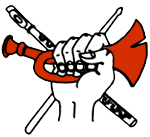Instruments & Transpositions
See also the page on instrument ranges.
The parts for the instruments in the marching band aren't all written in the same way. For several, the notes are transposed into another key. This makes more work for composers and arrangers, but it's easier for musicians to change to a new instrument, because the fingering will be closer. The notes will also be better placed on the clef (neither too high nor too low).
| Key | Instruments |
|---|---|
| C (treble clef) |
|
| C (bass clef) |
|
| B flat |
|
| E flat |
|
| F |
|
B flat instruments read music a whole tone higher than the piano, E flat instruments read music a major sixth higher, and F instruments read a fifth higher. For example, the note which is written as C for the piano is written as D for the trumpet, G for the French horn, and A for the alto sax. A complete table of transpositions for the entire scale is given below.
| Instrument transposition | |||
|---|---|---|---|
| C | B♭ | E♭ | F |
| Transposition of the scale | |||
| C | D | A | G |
| C♯/D♭ | D♯/E♭ | A♯/B♭ | G♯/A♭ |
| D | E | B | A |
| D♯/E♭ | F | C | A♯/B♭ |
| E | F♯/G♭ | C♯/D♭ | B |
| F | G | D | C |
| F♯/G♭ | G♯/A♭ | D♯/E♭ | C♯/D♭ |
| G | A | E | D |
| G♯/A♭ | A♯/B♭ | F | D♯/E♭ |
| A | B | F♯/G♭ | E |
| A♯/B♭ | C | G | F |
| B | C♯/D♭ | G♯/A♭ | F♯/G♭ |
A simpler way to remember how to transpose from one instrument to another is the circle of fifths, which shows the number of sharps and flats for each key. To transpose from concert C to B♭, move two positions clockwise along the circle: a song written in C major for the flute would be written in D major for the trumpet or clarinet, and a song written in G major would be transposed to A major. To transpose from C to F, move one position clockwise. To transpose from C to E♭, move three positions clockwise. To transpose from B♭ back to concert C, move two positions counter-clockwise, and so on.
![[circle of fifths]](../sites/default/files/page_files/circle_of_fifths.png)
